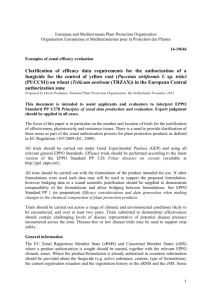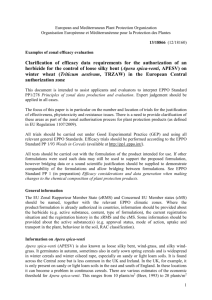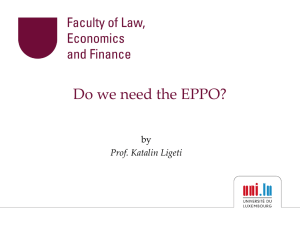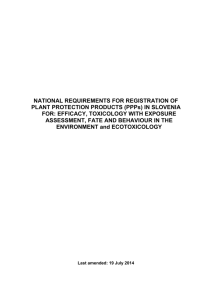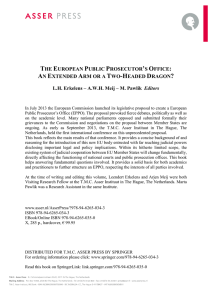Mycosphaerella graminicola - Septoria leaf blotch
advertisement
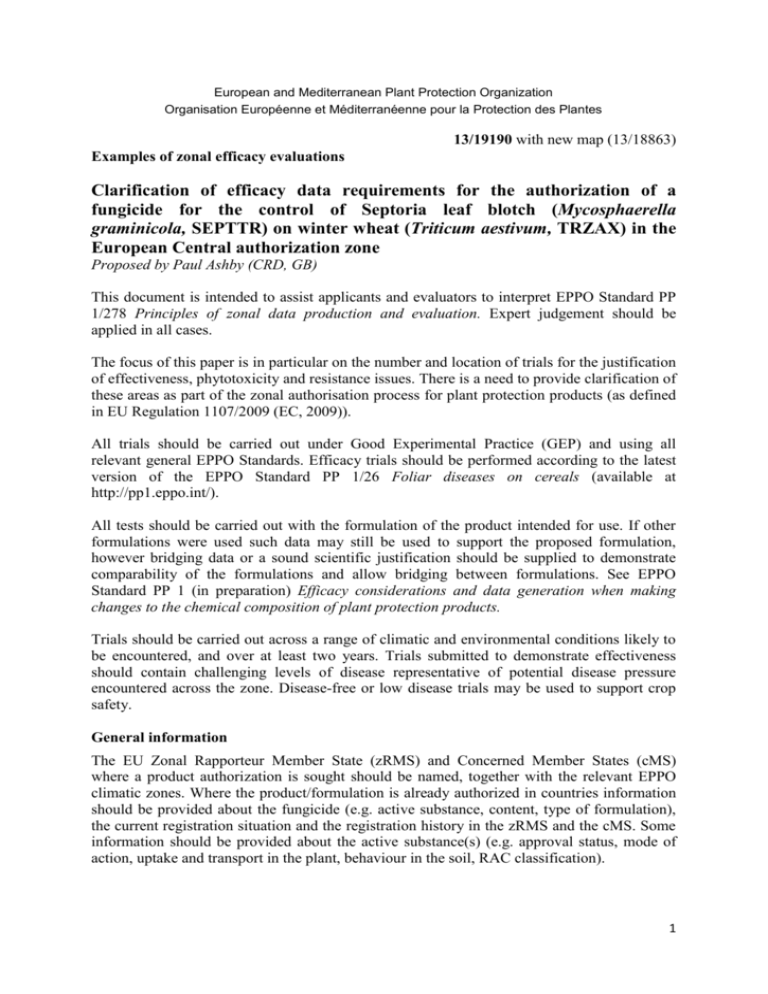
European and Mediterranean Plant Protection Organization Organisation Européenne et Méditerranéenne pour la Protection des Plantes 13/19190 with new map (13/18863) Examples of zonal efficacy evaluations Clarification of efficacy data requirements for the authorization of a fungicide for the control of Septoria leaf blotch (Mycosphaerella graminicola, SEPTTR) on winter wheat (Triticum aestivum, TRZAX) in the European Central authorization zone Proposed by Paul Ashby (CRD, GB) This document is intended to assist applicants and evaluators to interpret EPPO Standard PP 1/278 Principles of zonal data production and evaluation. Expert judgement should be applied in all cases. The focus of this paper is in particular on the number and location of trials for the justification of effectiveness, phytotoxicity and resistance issues. There is a need to provide clarification of these areas as part of the zonal authorisation process for plant protection products (as defined in EU Regulation 1107/2009 (EC, 2009)). All trials should be carried out under Good Experimental Practice (GEP) and using all relevant general EPPO Standards. Efficacy trials should be performed according to the latest version of the EPPO Standard PP 1/26 Foliar diseases on cereals (available at http://pp1.eppo.int/). All tests should be carried out with the formulation of the product intended for use. If other formulations were used such data may still be used to support the proposed formulation, however bridging data or a sound scientific justification should be supplied to demonstrate comparability of the formulations and allow bridging between formulations. See EPPO Standard PP 1 (in preparation) Efficacy considerations and data generation when making changes to the chemical composition of plant protection products. Trials should be carried out across a range of climatic and environmental conditions likely to be encountered, and over at least two years. Trials submitted to demonstrate effectiveness should contain challenging levels of disease representative of potential disease pressure encountered across the zone. Disease-free or low disease trials may be used to support crop safety. General information The EU Zonal Rapporteur Member State (zRMS) and Concerned Member States (cMS) where a product authorization is sought should be named, together with the relevant EPPO climatic zones. Where the product/formulation is already authorized in countries information should be provided about the fungicide (e.g. active substance, content, type of formulation), the current registration situation and the registration history in the zRMS and the cMS. Some information should be provided about the active substance(s) (e.g. approval status, mode of action, uptake and transport in the plant, behaviour in the soil, RAC classification). 1 Information on the disease Septoria leaf blotch is caused by the fungus Mycosphaerella graminicola1. Mycosphaerella graminicola is the name of the sexual stage (teleomorph) of the pathogen. The disease is more commonly referred to as Septoria tritici which is the name of its asexual stage (anamorph). The disease is widely distributed across the main wheat growing regions of the world. Yield losses in badly infected susceptible varieties can be major with reductions of up to 50% reported in the UK. A new distribution map is provided for Mycosphaerella graminicola (Fuckel) Schroeter. Hosts: Wheat, (Triticum spp.) and other. CABI Distribution Maps of Plant Diseases, 1986, October (Edition 3), Map 397, http://www.cabi.org/DMPD/ The disease is most damaging in regions where periods of rainfall and leaf wetness are more common. Within the EU Central authorization zone the disease is more frequently damaging in the EPPO Maritime regions where it usually occurs first during the winter months. The initial infection arises from wind borne ascospores released from debris. Once a spore has landed on a new leaf, it is reported to take 12 hours for the spore to germinate; infection of the new leaf usually takes place within 24 hours of the spore being released. Wet conditions are required during this infection process. Leaf wetness can be caused by either rain or dew, so, spore dispersal and infection can still take place even during dry weather spells. Symptoms do not appear immediately on a new leaf. The fungus grows undetected inside the leaf for a period of 14-28 days (‘latent phase’). The speed of visible symptom development is linked to temperature so during the winter it can take a long time for symptoms to appear, while in the summer, symptoms can develop more rapidly. The existence of such a relatively long latent phase can make interpretation of results difficult as, for example, the effectiveness of fungicides with eradicant activity can be greatly reduced if applied during this phase. The disease is most severe where these conditions are prevalent during the stem elongation phase of crop development. Further spread of the disease up the growing plant and onto the main yield producing higher leaf levels is primarily the result of the splash borne release of asexual pycniospores. Frequent cycles of infection can occur throughout the lifetime of the crop. These life cycle characteristics make Septoria tritici a particularly challenging disease for field experimenters to present a supporting effectiveness data package. A useful source of further information on this disease is the website of the American Phytopathology Society. The effectiveness of a product is best judged using assessments of the severity of the disease on identifiable leaf levels; assessments of product effectiveness based on disease incidence should be avoided. The disease is generally not considered to be seed-borne. Some active substances (e.g. some azoles) have been shown to have limited activity in reducing the early seedling blight stage of the disease. FRAC SDHI working group reports indicate that the SDHI’s are also being developed as seed treatments. The high systemicity and intrinsic activity of some SDHIs 1 It has recently been proposed that Mycosphaerella graminicola should be reclassified as Zymoseptoria tritici Quaedvlieg W, Kema GHJ, Groenewald J, Verkley GJM, Seifbarghi S, Razavi M, Gohari Mirzadi A, Mehrabi R & Crous PW (2011) Zymoseptoria gen. nov.: a new genus to accommodate Septoria-like species occurring on graminicolous hosts Persoonia - Molecular Phylogeny and Evolution of Fungi 26: 57–69. http://www.ncbi.nlm.nih.gov/pmc/articles/PMC3160802/?tool=pmcentrez doi:10.3767/003158511X571841. PMC 3160802. PMID 22025804. 2 against foliar diseases such as Septoria tritici may result in their development as cereal seed treatments with activity against this pathogen. When assessing the absolute level of activity of a foliar applied fungicide, it is important to establish whether a maintenance treatment or seed treatment with potential or known activity against this disease has also been used. The use of maintenance products with activity against Septoria tritici is best avoided as they make the interpretation of the activity of the test product difficult to establish. A full justification must therefore be provided to explain the relevance of any trials in which such maintenance products have been used. Information on wheat production in the Central Zone Wheat production occurs in the whole central registration zone of the European Union. The main countries for wheat production in the central registration zone are: France (Maritime regions), Germany, UK and Poland. Further information on wheat production is available from the Eurostat website and from the Belgium study on the distribution of crops in Europe available on EPPO zonal webpage. http://www.eppo.int/PPPRODUCTS/zonal_efficacy/zonal_efficacy.htm. The applicant should always make sure that reliable and recently updated sources of information are used. Intended Use(s) The applicant should clearly describe the details of the recommended use for each country where registration is sought. (See EPPO Standard PP1/240, Harmonized basic information for databases on plant protection products particularly points 15 - 34). Number and distribution of trials required for an authorization Effectiveness (6.2) Commission Regulation 284/2013), (OECD KIIIA1 6.1.3) To support an authorization in the Central Zone, which encompasses different EPPO climatic zones, more than the EPPO recommended number of trials results (6-15) for a single EPPO zone will be needed. The Central European registration zone encloses three different EPPO zones of comparable climates: the Maritime zone (Ireland, United Kingdom, The Netherlands, Belgium, Luxembourg, Germany, Czech Republic and Austria), the North-east zone (Poland) and the South-east zone (Slovenia, Slovakia, Hungary and Romania). The climatic variation across the central registration zone, particularly with respect to temperature and rainfall during the main period of crop growth is high. This variability largely explains the differences in severity of Septoria tritici across the zone. Climatic variability may have an impact on the product performance and response. However, the greatest impact of the climate variability is expected to be on development and subsequent severity of the disease. Regions with drier spring/early summer climates (e.g. South Eastern EPPO countries) typically have less severe and shorter epidemics. In these countries the GAP (in terms of the dose and the number of applications) may differ from that required in the more disease prone wetter Maritime countries. Trials should cover the typical variation in climatic conditions. Where data suggest lower required doses in some areas, it may be necessary to conduct further trials to support the proposed doses. When planning the number and distribution of trials required for an authorization in the central zone, the majority of the trials (minimum of 10 fully supportive trials) should be carried out in the locations where Septoria tritici is most severe, typically in the 3 central/western regions maritime EPPO zone (indicated with red diamonds in Figure 1). Note that it is also possible to perform some of these trials in the North of France, where this disease can also be important, and Denmark because of their comparable climate (maritime climatic EPPO zone), although these countries do not belong to the central EU registration zone (Figure 1). It is important in these trials that disease developed to challenging levels in the untreated plots. To cover the whole range of climatic variation, a minimum of 6 fully supportive trials should be performed in the other climatic EPPO regions, although conditions are less challenging here. Diseases levels in such areas would not be expected to be as severe, but it is important to encompass a range of disease pressures. Possible locations of these trials are indicated in blue in Figure 1. Also some trials located in countries of the North East and South East climatic EPPO zone which do not belong to the Central EU registration zone, but with comparable climate may be relevant (see Figure 1, e.g. LT and BG). Data should be presented separately for high disease pressure of the Maritime region and for low diseases pressure of the North- and South-East regions to enable a consideration of whether there is any impact of climatic conditions on performance. Quantitative yield data should be presented as specified in EPPO standard PP1/26. Figure 1: Visualization of the planning of trials for Septoria tritici in wheat. Note that this is a schematic overview of the distribution and do not show exact locations (e.g. instead of a trial in Germany, a trial in the UK or North of France is also possible). 4 Minimum Effective Dose (6.2) (OECD KIIIA1 6.1.2) Data generated across a range of disease pressures (as described above) is important in determining whether a single dose is appropriate for the whole zone, or whether the claim should differentiate depending on disease pressure. The claimed dose(s) should be justified by including at least one dose below the recommended one in some trials (see EPPO PP1/225 for more information). Some justification of the proposed dose for high disease pressure of the Maritime region and for low diseases pressure of the North- and South-East regions should also be provided because the performance of the product may be influenced by climatic conditions. In addition consideration should also be given to the number of applications needed across the different EPPO climate regions. Resistance (6.3) (OECD KIIIA1 6.2.8) Reference should be made to EPPO Standard PP 1/213 Resistance Risk Analysis. There is a history of reduced sensitivity, including associated reductions in field performance, to a range of fungicides (MBCs, DMIs, QoIs) for this pathogen2 with different levels of resistance. For a new active substance (not belonging to an existing mode of action group) the variability in sensitivity (baseline data) should be established from sites in which no previous usage of this active substance has occurred following the principle outlined in EPPO Standard PP1/213. Isolates should be taken from a range of the main wheat growing areas within the Central zone. Where the new active substance is from an existing mode of action (MOA), recent sensitivity data should be provided, although it may not be possible to establish true baseline sensitivity. Where shifts in sensitivity have been reported for the MOA it will be necessary to establish the pattern of cross-resistance within the group. It is also important to investigate the cross resistance pattern between the new active substance and other commonly applied cereal fungicides from other MOA particularly where reductions in field performance have been reported. For this pathogen, where a medium/high resistance risk is likely to be predicted, a resistance management strategy should be proposed. Detailed resistance management strategies will often need to be country specific. Reference may be made to relevant ‘Resistance Action Committee’ (RAC) recommendations, but should be tailored to individual Member States and reflect e.g. number of applications required, availability of other control options etc. In particular any advice from local ‘Resistance Action Groups’ should be followed, along with any individual National statutory restrictions. Phytotoxicity to target plants (including different cultivars), or to target plant products (6.4.1) (OECD KIIIA1 6.2.1, 6.2.5, KIIIA-6.1.4.1-3) Observations for phytotoxic effects should be made in all effectiveness trials. Trials should be conducted with a range of varieties. Specific crop safety trials are only required if phytotoxicity is observed in the effectiveness trials. In such cases, yield data are necessary. Phytotoxicity can vary depending on climatic conditions and varietal tolerance. Therefore, it is necessary to have phytotoxicity data from all the different EPPO climatic zones of the authorization zone and for a range of varieties. For more information about phytotoxicity assessment see EPPO Standard 1/135 Phytotoxicity assessment. 2 Further information on the resistance status of this disease is available from: FRAC List-of-resistant-plantpathogens and the EPPO Septoria leaf blotch Workshop (Harpenden 2010) Links could be also found at http://www.eppo.int/PPPRODUCTS/resistance/resistance.htm 5 In preparation of the biological dossier, the applicant should consider whether there is a need for data on possible effects of the test product on transformation processes. For fungicides some intrinsic activity against yeasts may be expected hence specific tests on brewing and baking are likely to be required. For more information see EPPO standard 1/243 Effects of plant protection products on transformation processes. Impact on treated plants or plant products to be used for propagation (6.4.5) (OECD KIIIA1 6.2.5) EPPO Standard PP1/135 Phytotoxicity assessment provides an indication of the circumstances under which data on plant parts for propagation are required. Impact on other plants, including adjacent crops (6.5.2) (OECD KIIIA1 6.2.7) The decision frameworks in EPPO Standards PP 1/207 Effects on succeeding crops and PP 1/256 Effects on adjacent crops should be followed when addressing these points. Effects on beneficial and other non-target organisms (6.5.3) (OECD KIIIA1 6.2.4) When there are claims for use as part of an Integrated Pest Management Strategy, special trials may be required on a national basis for fungicides in cereals. Relevant data produced for the Ecotoxicology section 9.5 or existing IOBC classifications for the active substance may be used. Extrapolation to other crops This example may be used for other cereal hosts. Septoria tritici is also reported to infect rye (Secale cereal, SECCE), triticale (Triticosecale sp. TTLSS) and durum wheat (Triticum durum, TRZDU). Where effectiveness in wheat has been adequately demonstrated and where these other crops are minor it may be possible to extrapolate similar claims of activity, although a limited number of trials to demonstrate crop safety are likely to be required. Where these other cereals are considered to be major, additional crop specific trials may be required to demonstrate both effectiveness and crop safety. To demonstrate effectiveness and crop safety 2-3 trials per crop may be sufficient in these situations provided wheat is fully supported. Further advice on the requirements for these other cereal crops should be sought from countries in which use is intended as in some cases claims may not be allowed if the disease is of such low importance that control is not justified. See also PP 1/257 Efficacy and crop safety extrapolations for minor uses. References Regulation (EC) No 1107/2009 of the European Parliament and of the Council of 21 October 2009 concerning the placing of plant protection products on the market and repealing Council Directive 79/117/EEC and 91/414/EEC. Official Journal of the European Union L 309, 1-50. Commission Regulation (EU) No 284/2013 of 1 March 2013 setting out the data requirements for plant protection products, in accordance with Regulation (EC) No 1107/2009 of the European Parliament and of the Council concerning the placing of plant protection products on the market http://eur-lex.europa.eu/LexUriServ/LexUriServ.do?uri=OJ:L:2013:093:0085:0152:EN:PDF OECD Guidance Documents for Pesticide Registration http://www.oecd.org/env/ehs/pesticides-biocides/oecdguidancedocumentsforpesticideregistration.htm 6

